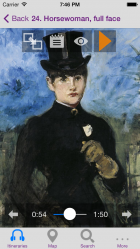
Portraiture is a genre that began with medieval altarpieces, on which the portraits of the usually aristocratic patrons who had commissioned the work were placed on the side panels. Later, they were widely used for the purpose of arranged marriages, so that the engaged couple could see what each other looked like before the wedding.
In this case, the portrait was commissioned by the husband, who was a member of the Tornabuoni family, in remembrance of his wife, Giovanna degli Albizzi, who died young. The Tornabuoni were bankers who were allies of the famous Medici family, the art patrons of the Florentine golden age. This lady is also shown full length in another portrait commissioned by the Tornabuoni, “The Birth of the Virgin Mary”, one of the large frescoes that decorate the church of Santa María Novella in Florence.
Ghirlandaio was a 15th century Italian Renaissance portrait who was a member of the School of Florence, and a contemporary of Boticcelli. Among his merits was having been Michelangelo’s first teacher.
The artist painted the portrait in profile, in the manner of a Roman coin. The perfection of the face, neck and bust, and the ornate dress have combined to produce one of the most beautiful portraits in the history of art. In the background, in the dark, there is a niche in which we can see an ornate coral rosary with a Latin inscription that reads “if the artist could have painted moral character and fabric, there would be no more beautiful painting on earth” and the date, 1488. A half-open book gives depth to the picture, and an original piece of jewellery on the shelf, matching those the sitter is wearing, completes the group. It was probably designed by the painter, who was also a famous goldsmith.
(c) (R) 2013, MUSMon com S.L.
Text (a) Catalina Serrano Romero
Picture
Source: Wikimedia Commons
Author: Kaldari
Permission: This artwork is in the public domain: The author of this artwork died more than 70 years ago. According to E.U. Copyright Law, copyright expires 70 years after the author's death. In other countries, legislation may differ.
Independently produced by MUSMon.com, the audio guide for the Thyssen-Bornemisza Museum offers you a wide-ranging, light-hearted and educational tour of one of Spain’s most outstanding art museums. It contains 90 minutes of commentary, illustrated with over 52 high-quality images, so you won’t miss a single detail during your visit.
We will guide you on your journey through the history of painting. +info




































































